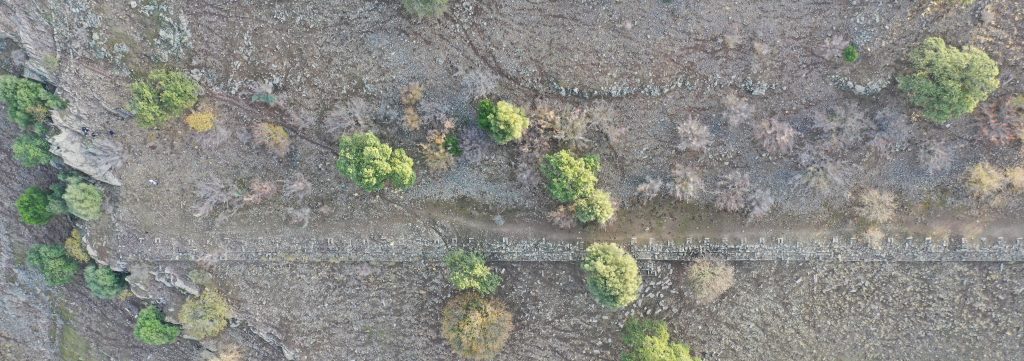
A city gate supported by two round towers is located on the southern walls of the city. The gate provides access from the south of the city, especially from the direction of Kyme, differs from other city gates with its elaborate architecture and size. A stone-paved road leading to the public buildings (Theater, Gymnasion, Gymnasion Bath, etc.) on the western terrace of the city is approximately 432 m long. At the 220 m of the road, a wide area located at the left draws attention. The flattened area, supported by an enormous retaining wall, is 225 m long and 20 m wide. Our German colleagues defined this flat area as Stadion during their study in the city in 1886. The sloping feature of the land provides suitable conditions for the sitting area. However, any trace of stone seating rows in the area cannot be detected. In this respect, it is necessary to consider the possibility that the seating rows may have been made of wood. The most important evidence of the existence of a stadion in the city is the inscriptions found in the ruins of the Agora Building. The inscriptions written on seven architrave blocks provide important information about the gladiator games held in the city. Under a single-line honorary inscription, there are two small, side inscriptions on a beam, inside the frames. The height of the letters in the main inscription is 0,07 m, and the letters on the side inscriptions is 0,04 m. τοῖς Σ[ε]|βαστοῖ[ς κα]|ὶ Ἀπόλλωνι | [Χρηστηρίῳ | καὶ τῷδάμῳ | [{ὁ δεῖνα τοῦ} — — —]|ς ἀγωνοθετή|σας ἐ[πεσκεύασε?] is written on the main inscription. The list of gladiators specialized in different games and the number of their victories are given in small inscriptions. As can be understood from the inscription, during the restoration of a building, three gladiator fights were organized, together with spectacular ceremonies. Free and slave gladiators fought in these games. The inscriptions written on seven architrave blocks provide important information about the gladiator games held in the city.
The Buildings in Aigai 62 (a, 1st Line) Herophilos, Charioteer-Gladiator (essedarius), free,won four times. (a, 2nd Line) Skaplas, Charioteer-Gladiator, slave, won five times. (b, 1st Line) Eros, Murmillo-Gladiator (murmillo), free, won eighteen times. (b, 2nd Line) Klados, Thraex-Gladiator (Thraex), slave, won …. (between eleven and nineteen?) times. (c, 1st Line) Hierokles, Charioteer-Gladiator, free, won twelve times. (c, 2nd Line) Bakkhios, Charioteer-Gladiator, free, won sixteen times. (c) Name .., won nine times. (e, 1st Line) Okys, Net-fighter (retiarius), slave, won eleven times. (e, 2nd Line) Beithys, Murmillo-Gladiator, slave, won five times. (f) Antiokhos, Charioteer-Gladiator, free, won seven times. Essedarius, one of the gladiator classes in the inscription, takes attention.
This name is thought to come from “essedum” the Celts’ chariot. How they fought is still controversial since there are not many descriptions of essedarius. According to some researchers, chariots were not needed for essedarius fights. They were used for demonstration purposes, at least at the beginning of the war as generally accepted. It is known that some gladiatorial games were held in theaters. But this is not the case for essedarius games. Because of that, there was probably a Stadion in the city. R. Bohn and C. Schuchardt say that honorary inscription does not mention a particular emperor, because of this reason, to determine the date of it is not possible. It is known that some gladiatorial games were held in theaters. Aigai 63 Also, they claim that the games may be related to the extensive building projects after the earthquake that occurred during the reign of the emperor Tiberius, but it was unlikely that gladiator games were held in Anatolia at such an early period. However, it is possible to make a dating based on the fact that the games listed were popular in the Early Imperial Period. An important event indeed had to occur for the organization of gladiator games of this size. The inscriptions similarly on architrave blocks uncovered in the city, indicating that Tiberius was honored for his help after the earthquake of 17 AD, were found in the area very close to the Upper Agora. The honorary inscriptions of Tiberius and the inscriptions on gladiator games were written on the same type of architrave blocks. Fully preserved blocks bearing both groups of inscriptions have similar measurements. They measure 2,55 m in length and 0,26 m in height. Thus, the honoring inscriptions of Tiberius and the inscriptions on gladiator games must be contemporary, and they must have belonged to one or two opposite stoai located on the Upper Agora.
